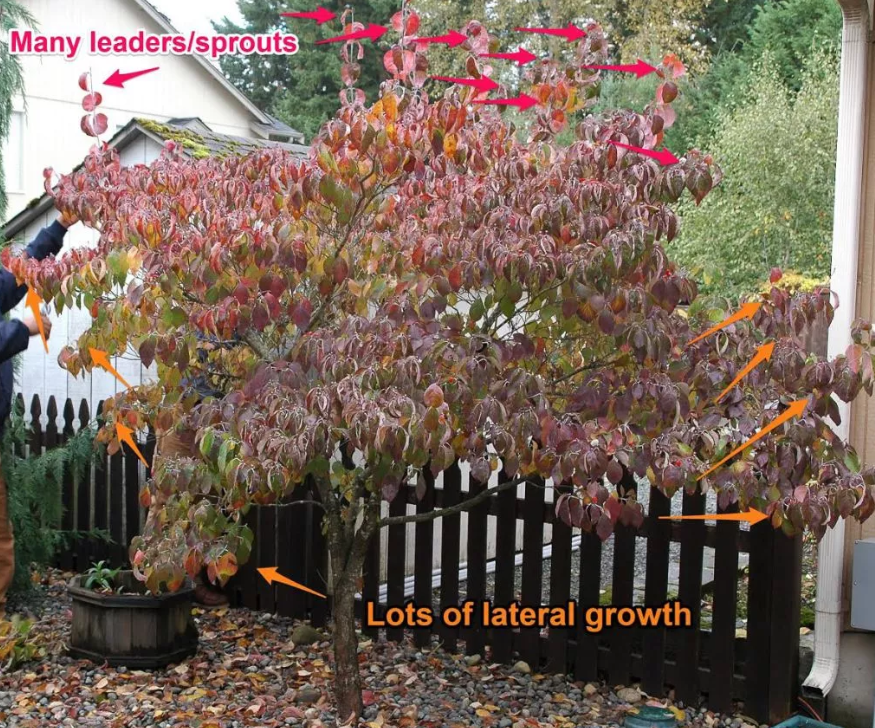Today we'll regale you with the Tale of 2 Dogwood Trees. Years before the start of our story, a client of ours rescued these trees and replanted them in their yard in the hopes they would rebound. With some TLC they bounced back with such vigor and set the stage for us to capture proper pruning techniques for both upright and lateral growth habits. Let's leaf through the details.

These identical Dogwood trees had very different growth habits. In this photo, the tree on the left exhibited an upright growth habit and pushed a central leader skyward (referred to as an A-Form tree for Apical dominance). The tree on the right couldn’t decide which branch was going to lead the way and laid out more lateral (referred to as a B-Form tree for Broad or open form). What a perfect scenario to document the difference between A-Form and B-Form trees and how each should be pruned!
Let’s look at the A-Form Dogwood tree more closely…

In this A-Form tree, we had to first choose which branch would serve as the central leader. Following the trunk up from the base, we chose the branch that was the clear extension of the trunk. This was not necessarily the tallest nor the largest branch. We then “headed back” the other branches that were vying for dominance to zap some of their energy, redirecting the energy to the chosen leader.
Next, we removed branches that were dying, broken, rubbing, or diseased. Bad branches need to be removed even if it causes poor visual balance because they can be detrimental to tree health if left unattended.
Keep in mind that only up to 30% of the canopy can be removed in a 1-year pruning cycle. We shaped the tree the best we could given this limitation. We reshaped the imbalance caused by lateral growth on the far left and removed a number of branches hanging over the walkway, and driveway.

While we would have liked to have pruned more, we stopped at our max of 30%. The pile of debris served as a visual to keep a track of how much was removed (bottom right-hand corner of photo). The result? A very attractive A-Form tree was well on its way to a more balanced shape. This tree will need to be pruned again next year and most likely the year after as well. The long-term goal is to prune every 3 years with just a minimum touch-up during the year. Well-maintained trees can be on a 3-year pruning cycle.
And what about the B-Form Dogwood tree?…

We then checked for and removed any branches that may have been broken, cracked, diseased, or rubbing on other branches.
To bring the tree back into some sort of shape, we balanced the lateral growth by removing branches that hung over the sidewalk or were hanging over the fence. Some of the low-hanging branches were “removed” at the trunk to get a more moderate tree-like shape. Competing laterals were reduced and branches that were either growing too close to each other or crossing were also reduced or removed.

This tree also reached its maximum 30% removal before we were ready to stop so we put this tree back on the list to be pruned again next winter. While both trees could still use some pruning they are now healthier and much better looking.
For your information: We used 3 pruning-cut terms in this article: Removal, Reduction, and Heading-Back. Removal cuts take the branch off at the trunk or point of origin; Reduction cuts take the parent branch back to a significant lateral branch; And Heading-Back cuts shorten a parent branch in between insignificant lateral branches.
A final note: Both trees exhibited stressful conditions during their early years. The A-Form Dogwood had pock marks where woodpeckers had searched for insects. We performed a Deep Root Feeding treatment to get critical nutrients and biological life down around the root structure as quickly as possible to help the trees be as healthy as they can be.
Want to learn more about Tree Pruning? Give us a call. We’d love to help.
Earthdance Organics | (253) 927-2523 | info@earthdanceorganics.com






